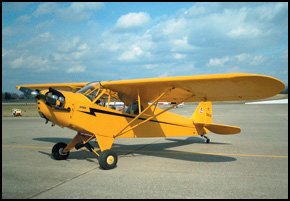
I’m flying Sunrise’s J3 up to a Cub fly-in at Lompoc this morning.
The official purpose is to try and drum up some business for the aircraft. The unofficial purpose: fun! I’ve been flying the plane quite a bit over the past couple of months and have to say it’s one of the most enjoyable planes I’ve flown. The windows and doors are usually left wide open, so you get an unobstructed view and lots of fresh air. It’s like an open cockpit biplane, but without the wind blast and sun exposure.
There are very few FBOs I can think of that operate out of a busy Class C airfield yet still an airplane available for rent that you can hand prop. But we do. And our bird was fully restored over the past few years, adding a larger engine along with the clipped wing modification. The shorter wing results in sportier handling — I’ll often make steep approaches at 90 mph and still end up with a very short landing roll.
Between that and the fact that we’re well know for our expertise with tailwheel aircraft, it’s hoped that this will inspire people to come down to Sunrise and fly the airplane.
It should be a pretty slow trip, though. The Cub is lucky to get 85 mph, even with the horsepower upgrade. I refer to it as “permanent MCA” (MCA = ‘minimum controllable airspeed’, or ‘slow flight’).
The plan is to stop at various airports along the way to put up flyers and show off the airplane. At Lompoc, there will probably be about 50 aircraft for the fly-in, which lasts through Sunday. There will be a spot landing contest, as well as a flour bomb drop competition.
This trip should be unique, because the J3 doesn’t have a charging system, just a battery. When it’s tied down at SNA, there’s a permanently mounted solar panel on the ground which supplies energy to recharge the battery. But we’re going to be gone for 60 hours and aren’t sure if the battery will hold enough juice to power the avionics for that long.
We sat down and computed the power draw from the avionics. The aircraft is equipped with Becker glider radios, which are both compact in size and miserly on the power consumption. The intercom draws about 0.1 amp. The transponder, which is the high draw item, only pulls 0.25 amps at 28 volts. We’re operating at 14 volts, so it’ll take 0.5 amps. Still, not bad!
Since we need the transponder and radio to get through the 30 nm mode C veil and Class C airspace, the plan is to turn everything off once we’re clear of Los Angeles and get back to basic, no frills pilotage. With any luck, this will preserve enough battery power to get us through the return trip across Los Angeles.
Flying. It’s an adventure!
See ya in a few days…

You should read the regs more closely. An unmodified Cub can enter the Mode C veil even without a transponder, because the regs contain an exception just for aircraft like the Cub.
My reading of 14 CFR 91.215(c) says that if you have an operable transponder, you must use it in all controlled airspace. Furthermore, common sense dictates it be used as much as possible for traffic avoidance.